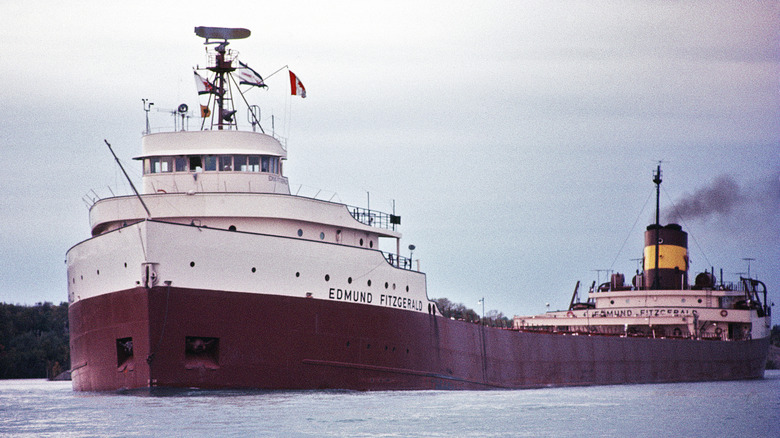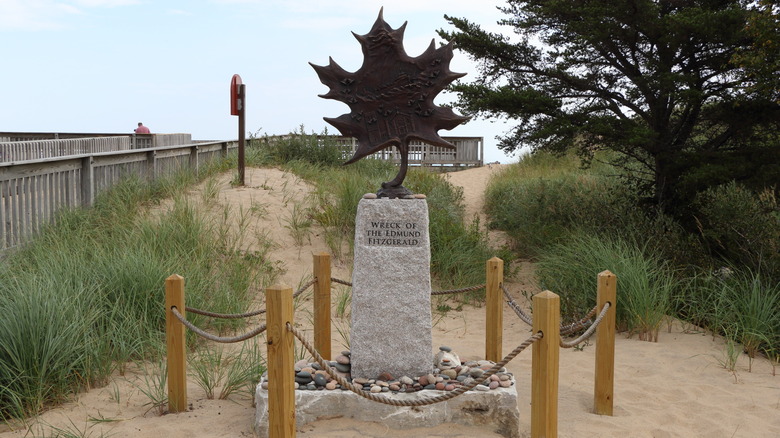How Historically Accurate Is Gordon Lightfoot's Song Wreck Of The Edmund Fitzgerald?
Editor's note: A prior version of this article indicated Whitefish Point was in Wisconsin; it has been updated to reflect its actual location in Michigan.
Throughout the history of popular music, sometimes songs about relatively obscure subject matters have made the charts. For example, Michael Sembello's 1983 hit "Maniac" is, according to Sonic News, about a serial killer, while Creedence Clearwater Revival's "Green River" is about a lime-flavored drink that John Fogerty enjoyed back in the day.
You would think that a mournful dirge about a fatal shipwreck would hardly be fodder for radio airplay and the Billboard Top 40, but leave it to Canadian troubadour Gordon Lightfoot to pull it off. His 1976 track "Wreck of the Edmund Fitzgerald" (posted on YouTube) is about the ship breaking apart and sinking during a storm on the Great Lakes, an event that actually happened in 1975, as the Great Lakes Shipwreck Museum describes. Lightfoot got the general structure of the event correct, but he had to take certain liberties in order to produce a compelling narrative with consistent rhyme and meter.
The real story of the Edmund Fitzgerald
The S.S. Edmund Fitzgerald embarked on its last journey on November 9, 1975, the year before Gordon Lightfoot released the "Wreck of the Edmund Fitzgerald." The Fitzgerald set out from the docks at Burlington Northern Railroad in Wisconsin at the leftmost edge of Lake Superior. It was carrying a huge load of iron ore weighing 26,116 long tons (2,240 pounds each), and was joined on its journey to Detroit by another ship, the Arthur M. Anderson. The Fitzgerald took the lead, and both ships sailed off same as they had many times before, with about a 10- to 15-mile gap between them.
When the ships headed out, their crews knew that a storm was approaching. This wasn't anything new, but less than an hour into the journey at about 3:30 p.m., the Fitzgerald reported having taken damage, presumably from waves. Captain McSorley of the Fitzgerald radioed Captain Cooper of the Anderson and said that they'd lost a rail, two vents, and that his ship had a list — a tilt — to one side. They wanted to get to Michigan's Whitefish Point across the lake as fast as possible, and continued on.
At about 7 p.m., two massive waves hit the Anderson and headed toward the direction of the Fitzgerald. The ships lost radio contact, and the Fitzgerald vanished. A three-day search starting November 14 found the Fitzgerald's underwater wreckage a mere 17 miles away from its intermediary destination, Whitefish Point.
[Featured image by Greenmars via Wikimedia Commons | Cropped and scaled | CC BY-SA 3.0]
Lightfoot's version of events
It's horrifying to imagine what the 29 people on board the Fitzgerald felt as they sank into the lightless dark of Lake Superior. As The New York Times explains, Lightfoot was inspired to write about the incident when he read that the Mariner's Church of Detroit rang their bell 29 times after the news broke about the shipwreck — once for each person lost. According to WRKR, Lightfoot initially wanted to get every point about the story just right, and was concerned about inaccuracies in the lyrics. Friend and producer Lenny Waronker, however, told him to "just tell a story." Lightfoot took this advice to heart, and told what might be considered a general tale of a shipwreck inspired by real events, rather than anything completely true-to-life.
One line in "Wreck of the Edmund Fitzgerald," for instance, says that the Fitzgerald was "coming back from some mill in Wisconsin" and was "fully loaded for Cleveland." Neither of those things was true. As stated, the ship set out from Wisconsin on Lake Superior, and was headed for Zug Island, Detroit. Similarly, as American Songwriter says, Lightfoot made the ship's cook a key character in the song, when in fact there's no knowledge of what he did or did not do during the Fitzgerald's voyage. The final verse also mentions a "musty old hall" in the "Maritime Sailors' Cathedral." This cathedral is actually called the Mariners' Church of Detroit, and is actually pretty bright and clean.
An unlikely classic
It doesn't seem like "Wreck of the Edmund Fitzgerald" would become a hit. It's a radio-unfriendly six minutes long, fairly subdued and languorous, and no one involved in its authorship or production thought the song would even be a single. And yet, it not only garnered a lot of attention, sales, and praise, it became Lightfoot's second-most successful song ever on the Billboard charts, after 1974's "Sundown," reaching No. 2. The song also had the unintentional effect of popularizing the shipwreck of the S.S. Edmund Fitzgerald to the point where it became a kind of urban legend. Unfortunately, divers started treating the shipwreck as a kind of pilgrimage sight, and the Canadian government — the Fitzgerald technically sunk on the Canadian side of Lake Superior — had to draft a law in 2006 to safeguard the wreckage.
Gordon Lightfoot, in an admirable gesture of respect, made adjustments to his song's lyrics over time in live performances to accommodate feedback regarding the song's accuracy and portrayal of events. For example, The New York Times tells us that he changed the lyrics to indicate that waves caused the shipwreck, not human error. WRKR also tells that some of the church-goers at the Mariners' Church of Detroit disliked their church being characterized as a "musty old hall." So, Lightfoot changed the lyrics to "rustic old hall." Ultimately, Lightfoot's song helped ensure that people never forget about the tragedy of the Fitzgerald's sinking.
[Featured image by Rklawton via Wikimedia Commons | Cropped and scaled | CC BY-SA 4.0]



